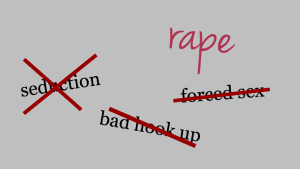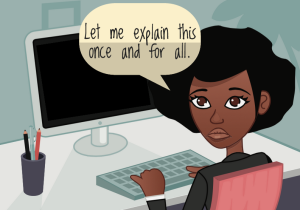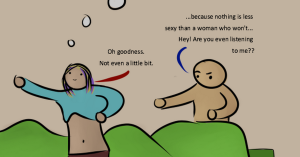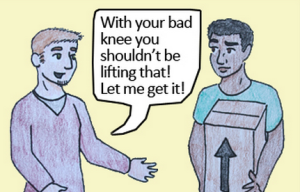
Source: Getty Images
Sometimes – well, most times – there’s pain in a relationship.
And sometimes, things can become so fragile and hard to navigate that irreparable cracks surface, and the relationship becomes broken.
You might feel confused, afraid, alone, deeply saddened, or betrayed. You might want to give up and move on, or you may want to stay. And those are all normal, natural, valid feelings to have when a relationship is at its breaking point.
But regardless of how it looks and feels to you, brokenness sucks. There’s no denying it.
Adding insult to injury, there simply are not very many helpful resources available to help you work on how to handle this.
Most self-help resources will focus on placing explicit blame on either your or your partner and come from a place of degradation instead of healing. They don’t give you peace of mind or help in repairing those wounds. They just put on a bandage, leaving you wondering why you’re still bleeding through, feeling more confused than before.
And I’ve been there. Far too many times. I understand what this is like.
I’ve felt the burden of carrying all of the emotional work of a relationship on my shoulders, of emotional abuse, of constant chaos and uncertainty from my partner.
I’ve been with liars and cheaters and mad men who have used me as a pawn in their games of psychological warfare.
It’s a pattern I’ve had to break.
Broken relationships, it must be noted, are not synonymous with abusive ones.
Having a broken relationship means that there have been boundaries crossed, promises broken, or trust shattered — but none of it done in a violent, coercive, or threatening way.
A broken relationship looks like someone cheating (and regretting it), a spouse lying about their finances, or a relationship in which both partners are always working to avoid being emotionally in touch with one another.
Abusive relationships cannot be healed because they don’t come from this same place of brokenness; they come from a place of power and control.
But learning, growing, and working hard to understand why brokenness breaks you – and what to do about it – is a journey. But it’s one worth taking.
Step 1: Identify (and Acknowledge) the Problem
Obviously, brokenness comes from some sort of ebb in your relationship with someone. It doesn’t just happen – there’s a reason, even if that reason is that they are an asshole.
And it will continue and hinder you from healing unless you can get to the root of the problem.
Where is your brokenness coming from? Is it felt on both ends equally? How is it affecting you and your relationship? What emotions and pain are you experiencing?
These questions can help you to reflect on the nature of the brokenness and help you to see where it is coming from and why it’s there.
If you can’t overcome the problems that lead you (and your loved one) to this place, you won’t be able to move forward.
It can also help to work with a therapist or counselor, if possible.
If not, try to find a trusted friend, mentor, or any one else that is close to you that you can open up and be honest with. It can even be someone you and the other person both know and trust.
That way, you can have someone to support you who can have a good understanding of how to help.
But remember: No one person can be your sole support. Because it can be emotionally taxing to help another person, it’s important to have a system of support made up of different people, services, and agencies that can help you in different ways.
Step 2: Have a Good Cry (or Twenty)
Our society doesn’t encourage us to let out our emotions. We’re expected always to wear a smile and never let down our guards; our cards should always be somewhat close to our vests.
So, even in our most intimate of relationships, it can be hard to show emotion or let the other person in on the emotions you’re feeling.
But it’s important to be in touch with your emotions.
Avoiding them or finding reasons to not connect with yourself on this level can cause you to hide from your feelings. Without working through your emotions and allowing yourself to feel, you’re not going to be able to heal.
Let yourself have a good cry, write in your journal, talk to someone, meditate, or even wallow in bed for a day – whatever you do to work through what you’re feeling in a healthy way.
Step 3: Practice Radically Honest Communication
You can never mend the wounds and rebuild trust without being completely honest with each other.
Set aside time every night, whether it’s two hours of fifteen minutes, and talk about your relationship – what’s bothering you, the progress you’ve made, setbacks you’ve faced, and the challenges you’re experiencing.
Have ground rules and agree that what you talk about stays there and agree to never deny or dismiss one another’s thoughts or experiences.
Open up and really share everything that you’ve always thought you couldn’t say. Say it. By opening up, trusting, and respecting in a safe space together, you’re going to nurture a strong bond.
A strong bond is what you will need to heal.
If both of you aren’t on the same page and really opening up and letting everything out, you aren’t going to be able to jump over any hurdles.
This is where you’ll need to choose to walk one of the two paths.
Path 1: Reevaluate Your Relationship
When the foundation upon which you built your relationship is broken, it’s important to go back and assess that relationship.
Brokenness reveals that there is something wrong in the way that you built your relationship.
The foundation could have been weak, or there were huge explosions that caused serious damage, or there might have been a lack of trust or communication. Whatever the issue was, it’s important to understand what needs to change.
It’s also important to think about whether or not the relationship is worth fighting for.
Sometimes, the damage was so severe or the trust completely shattered that trying to rebuild the relationship isn’t going to work, but working to rebuilding yourself is what you need.
Recognize that and know when to tell the difference.
Path 2: Walk Alone
Sometimes, brokenness can’t be healed.
The wounds are too deep, the trust has been too compromised, or you just can’t handle the stress.
If you are grasping at straws and don’t feel that there is any way to go on or make progress, allow yourself to break free. Know when to walk away.
Staying in a broken relationship that has little to no chance of ever getting better will just make you miserable. Trust me, I’ve been there.
Letting go can be the hardest thing to do. It means that you have to walk alone and leave that person behind.
But it can also be the most liberating thing you can do.
After the initial pain and sorrow, you can start to really heal. You can open yourself up to new friendships and relationships and have a fresh start.
Step 4: Keep Things in Perspective
Brokenness can often leave you feeling like you can never get through. It can be hard to see past the pain and visualize a better future for yourself or your relationship. You might not be sure if you can ever forgive or move on.
But, it’s important to keep in mind all of the other travesties in your life that you’ve survived, all of the other challenges that you’ve overcome.
It might seem hard, but you can and will survive.
You will get through this.
—
Healing from brokenness is never easy.
It requires a lot of perseverance, patience, kindness, and understanding. Always remember that relationships take two and that both parties need to be committed to healing and changing in order for it to work.
But don’t forget about the relationship that you have with yourself. You will probably need to do some of your own healing, whether you continue the relationship or not.
Trust yourself and do what is best for you.
Want to discuss this further? Login to our online forum and start a post! If you’re not already registered as a forum user, please register first here.
Erin McKelle is a Contributing Writer and Online Community Manager for Everyday Feminism. She’s an e-activist, video blogger, student, and non-profit advocate and has launched several projects including Fearless Feminism and Consent is Sexy. In her spare time, Erin enjoys reading, writing bad poetry, drawing, politics and reality TV. You can find her blogging at Fearless Feminism, Facts About Feminism, and Period Positive. Follow her on Twitter @ErinMckelle and read her articles here.
Search our 3000+ articles!
Read our articles about:
Our online racial justice training
Used by hundreds of universities, non-profits, and businesses.
Click to learn more




















